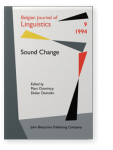Naomi Nagy
List of John Benjamins publications for which Naomi Nagy plays a role.
Journal
Title
Social Lives in Language – Sociolinguistics and multilingual speech communities: Celebrating the work of Gillian Sankoff
Edited by Miriam Meyerhoff and Naomi Nagy
[IMPACT: Studies in Language, Culture and Society, 24] 2008. ix, 365 pp.
Subjects Multilingualism | Sociolinguistics and Dialectology | Theoretical linguistics
2022 Chapter 12. Differential object marking in heritage and homeland Italian Variation in Second and Heritage Languages: Crosslinguistic perspectives, Bayley, Robert, Dennis R. Preston and Xiaoshi Li (eds.), pp. 311–336 | Chapter
We examine variable patterns of use of differential object marking (DOM) in conversational Italian recorded in Toronto, Canada, and Calabria, Italy. An exhaustive sample of 366 direct objects, produced by Homeland and three generations of Heritage speakers, shows retention of the DOM system.… read more
2019 Classifier use in Heritage and Hong Kong Cantonese Regional Chinese in Contact, Walker, James A. (ed.), pp. 84–108 | Article
Heritage language speakers have frequently been reported to have language skills weaker than homeland (monolingual) speakers. For example, Wei and Lee (2001, p. 359), a study of British-born Chinese-English bilingual children’s morphosyntactic patterns (including classifier use), report… read more
2013 Voice onset time across the generations: A cross-linguistic study of contact-induced change Multilingualism and Language Diversity in Urban Areas: Acquisition, identities, space, education, Siemund, Peter, Ingrid Gogolin, Monika Edith Schulz and Julia Davydova (eds.), pp. 19–38 | Article
We investigate Voice Onset Time (VOT) of voiceless stops in conversational speech in a transitional bilingual context. We examine the speech of three generations of bilinguals whose Heritage Language (HL) is one of three European languages (Italian, Russian, or Ukrainian) and who also speak English. read more
2009 17. The challenges of less commonly studied languages: Writing a sociogrammar of Faetar Variation in Indigenous Minority Languages, Stanford, James N. and Dennis R. Preston (eds.), pp. 397–417 | Article
The study of minority languages highlights the need for variationist approaches to grammars. This article addresses some conflicts that arise when we combine the enterprises of writing a descriptive grammar and constructing a sociolinguistic description of a language. Conflicts between conciseness… read more
2008 Subordinate clause marking in Montreal Anglophone French and English Social Lives in Language – Sociolinguistics and multilingual speech communities: Celebrating the work of Gillian Sankoff, Meyerhoff, Miriam and Naomi Nagy (eds.), pp. 273–313 | Article
We investigate the variable presence of overt complementizers in the bilingual repertoire of young Anglophone Montrealers, examining approximately 1,600 sentences in spoken French and English. The effects of linguistic constraints are compared between their two languages, and also to recent… read more
2008 Introduction: Social lives in language Social Lives in Language – Sociolinguistics and multilingual speech communities: Celebrating the work of Gillian Sankoff, Meyerhoff, Miriam and Naomi Nagy (eds.), pp. 1–16 | Article
2000 Stress and Schwa in Faetar Phonological Theory and the Dialects of Italy, Repetti, Lori (ed.), pp. 238–254 | Article
1994 Language Contact: Italian (?) geminates in Faetar Sound Change, Dominicy, Marc and Didier Demolin (eds.), pp. 111–128 | Article
Abstract. Faetar, an isolated dialect of Francoprovençal spoken in one village in southern Italy, shows clear evidence of Italian influence due to extended contact. One indication that Italian has influenced this dialect is the presence of geminates, as Gallic Francoprovençal had lost all length… read more








